
Over six articles we're publishing a detailed outlook from ANZ NZ's economics team on six key themes for 2015.
Here is the fourth one. (Links to the previous themes are at the bottom of this page.)
By Cameron Bagrie*
Dairy incomes boomed in 2013/14 and the terms of trade soared, providing considerable impetus across the economy.
A halving in dairy prices this season raises questions about the prospects for the sector itself and wider economy.
A rebound in prices is expected and has started to occur. But will the bounce be strong enough to ward-off further cuts to the 2014/15 outlook and provide more than a break-even result in 2015/16?
Dairy farm profitability is underwater in 2014/15; a lot of leverage has been accumulated; farm prices are elevated and asset valuation metrics stretched; and spot prices still need to lift further for current industry forecasts to materialise.
One year of challenge is manageable; two years would be problematic.
THE ROUT
The rout in dairy prices can be put down to three key factors:
• A bow wave of global milk supply from key export regions. The uptick in supply from the major global exporters has been the largest in eight years. Over the last 18 months, monthly milk supply from the major exporters has averaged annualised growth of 3.5%, which is well above medium-term growth (8-year period) of closer to 1.9%.
• China over-bought during the fi rst half of 2014, leading to an overhang of inventory.
• Russian bans on dairy imports from 28 countries. Russia is the second-largest global importer accounting for 12-15% of globally traded product. It was also Europe’s largest export destination, accounting for 22% of trade prior to the ban. The ban effectively reduces Russian dairy consumption and means European milk has had to fi nd a home elsewhere.
Collapsing dairy prices have necessitated successive downward revisions to the 2014/15 milk price.
Fonterra currently stands at $4.70/kg MS and the other independent milk companies are either side of this depending on their product mix and currency hedging. Including financing costs, that is below the cost structure of a typical owner-operator farm, meaning expenditure and cost structures are being closely looked at.
It’s an income loss to the economy of $6.3 billion, or 2.9% of GDP, though we need to be careful making such comparisons from an extraordinary peak to an 8-year low. Cash-flow for the sector this season is not as bad as the headline numbers suggest, due to the high deferred payments from the year before, but things are set to tighten in the July to October period.
OUTLOOK
The greatest concern for the industry and broader economy remains the outlook for the sector’s cash-fl ow over the coming 18 months. Both the fi nal milk price for 2014/15 and opening advance in May for 2015/16 will be particularly infl uential. At present:
• Spot prices are still below break-even.
• Prices need to lift to US$3,500 per tonne by the middle of the year just to deliver Fonterra’s current forecast of $4.70/kg MS for 2014/15. This looks a stretch. And they need to lift even more to deliver something above break-even in the 2015/16 season.
• The NZD is down but it’s still high and we suspect will remain elevated given New Zealand’s yield differential to other markets.
• There has been a considerable build-up in leverage across the sector from the early 2000’s. This hasn’t stopped since the global fi nancial crisis (GFC) either, with total sector debt having grown by 43% since 2008.
• Dairy-aligned land prices have surged again with the REINZ all-farm index, which adjusts for compositional differences, up 51% over the last two years and dairy farm prices up 31%.
• The processing industry is in the midst of the biggest investment cycle ever. In 2014/15 about $1.7 billion worth of new processing and associated facilities will be completed and a further $1.2 billion has been earmarked for coming years.
However, there are some key mitigating factors:
• Cost structures have been far better controlled than during prior periods when the dairy payout surged.
• Leverage is heavily concentrated with around half the debt held by 20% of farmers. Many of these are larger/corporate operations that tend to have more balance sheet fl exibility and often better financial performance from investment in key areas. Lower interest rates have reduced interest costs despite an increase in debt levels. On the typical farm this has seen interest servicing costs decline by nearly $0.50/kg MS since the GFC.
• Productivity growth has been impressive and has run 3.5% above trend (as measured by MS/ cow) over the last three years.
• There has been a huge amount of investment back into dairy operations over the last fi ve years. According to Dairy NZ the average farm undertook $850,000 of capital expenditure, with $720,000 of this funded from retained earnings. This creates more “flex” for cost structures during leaner times, has created greater efficiencies and adds to productive capacity.
• We expect there to be more pep from other income and the dividend for Fonterra shareholders.
Nonetheless, prospects for the headline milk price and international prices remain key, both for those within the industry and the broader economy.
THE CYCLE - SUPPLY DRIVEN
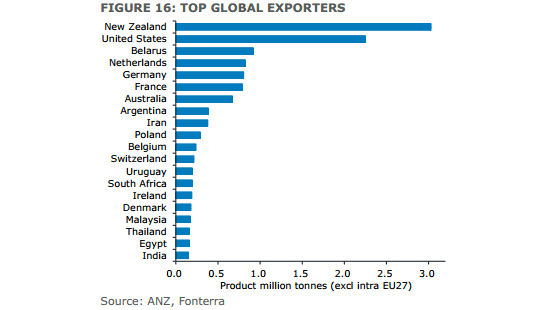
The cycle in dairy prices over the last 8 years has been heavily infl uenced by supply. The present oversupply situation can be traced back to the end of 2013 through to the middle of 2014 when record farm-gate prices across all the major exporting regions combined with lower feed costs and good seasonal conditions led to strong gains in dairy production (predominantly via higher yields, rather than many more cows).
The bow wave has been so great it has created the largest supply upswing in eight years.
The timing and magnitude of the impact on prices of all the additional milk has been uneven across the different product categories and major producers.
This has caused pricing mismatches and lagged farm-gate supply adjustment across several major exporters. These anomalies are now beginning to correct after a slow start due to various reasons.
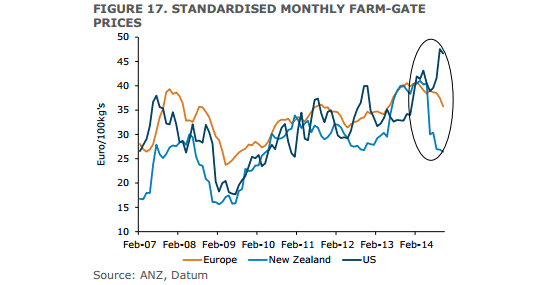
New Zealand farm-gate prices have so far borne the brunt of the downturn, but the effects of lower dairy product prices are now starting to be felt more widely.
The spread in farm-gate prices between New Zealand and Europe/US was at its widest in the last 8 years over the final quarter of 2014. Reduced farm-gate prices across the US and Europe combined with low prices in New Zealand has slowed supply growth, which is helping re-balance the market (refer Figure 18).
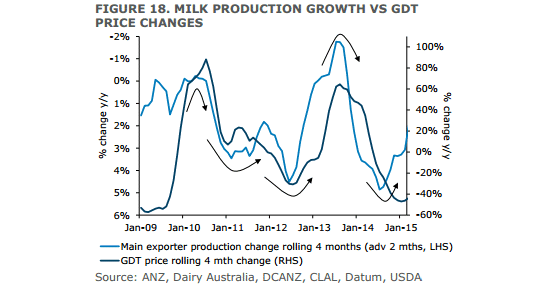

We are anticipating milk supply growth of 1.3% in 2015 across the three major export regions (NZ, Europe and US), who account for nearly 70-75% of total cross-border trade.
If milk supply growth slows to this level across the main exporters it would typically imply a 30-40% lift in GDT auction prices by the second half of 2015.
The recovery is likely to be toward the bottom end of this range though. The bow wave of milk from 2014 and associated inventory will take the market some time to clear; Europe is likely to have high exportable supplies in 2015 despite softer milk supply growth; and demand from the major importers looks weak until at least the second half of 2015, if not longer.
Europe’s exportable supply is expected to remain high due to the ban on exports to the Russian market and weak demand even if it reopens.
Russia was Europe’s largest export market, accounting for 22% of trade – and 12-15% of global import demand – prior to the ban. Even before the ban there were moves afoot to restrict imported dairy products and boost domestic support for farmers. This and the current political situation imply the ban will last much longer than August this year.
And even if the ban were to be lifted, import demand will likely be weak due to the collapse in Russia’s economic fortunes with the fall in oil prices and the dramatic 50% decline in the ruble.
Combined with trade restrictions, these dynamics point to a dramatic decline in dairy consumption. This will mean Europe will focus more on milk powder production, where additional capacity has been added for post quota removal in effi cient producing countries and in many key New Zealand markets.
Weak domestic economic conditions and a lower euro are also expected to increase the attractiveness of exporting over the domestic market. So while supply growth might be moderate, export competition is expected to remain high.
THE TREND – DRIVEN BY COST OF PRODUCTION AND DEMAND
Demand growth during the second half of 2013 and over much of 2014 was choked off in many emerging markets as high wholesale prices fed through to retail. This highlights the importance of affordability for demand growth in many emerging markets.
While demand elasticity varies greatly across the major emerging importers and strong lifts in real incomes are occurring, households in many markets spend a large proportion of their disposable income on food (25%+).
Affordability is best highlighted by the wide divergence in the amount of work required to purchase a litre of fresh milk. In many cases New Zealand’s main markets sit at the higher end on this measure.
For China it takes 6.5 times more hours of work for the average Chinese consumer to purchase a litre of milk than it does the average New Zealander. Compared with the US it takes 16 times longer!
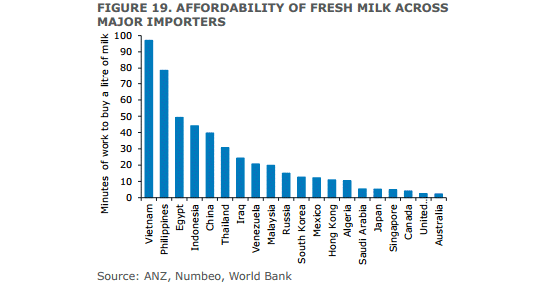
Near-term, the reverse of what occurred through 2013/14 should apply as 2015 progresses.
Lower wholesale product prices should start to feed through to retail prices, improving affordability and stimulating demand once again. But with Russia out of the market (12-15% of global import demand) more of the heavy lifting will have to be done by other countries.
Prospects for many of these major importers are still looking shaky, so we are cautious about how quickly this dynamic will flow through.
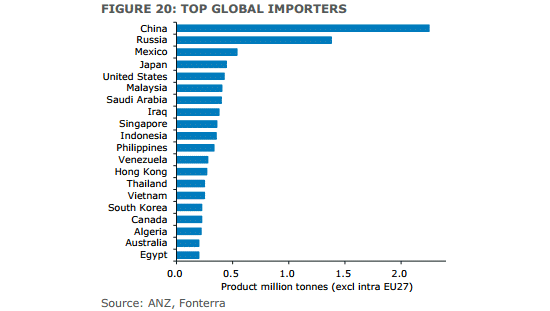
CHINA
Much has been written about the drop in China’s import demand and overhang of inventory from early 2014. Domestic production appears to have picked up, driven by high farm-gate prices, a mild summer and ongoing investment in large-scale farms.
Some of the increase will have been made into WMP, which, combined with high imports from the first half of 2014, seems to be suppressing import demand.
At present a range of estimates put China’s inventory at 150,000-400,000 tonnes of product, but there is no way of accurately knowing. There is reportedly discounting occurring for product getting close to its use-by date, which means it will clear out of the system over coming months, but many traders are wary of buying in large quantities again after being burnt by the fall in prices in 2014.
Overall, we expect China’s import demand to pick up in the second half of 2015 as inventories are cleared, the seasonal peak in domestic supply (Q2) passes and lower wholesale product prices feed through to retail stimulating demand growth.
Medium-term import demand is expected to be supported by counter-seasonal supply needs, food safety concerns with local supplies, and the high local cost of production.
OUTSIDE OF CHINA AND RUSSIA
Other emerging Asian countries are very important secondary markets. Import demand looks to be under pressure as their currencies depreciate against the USD.
European exporters also appear to be targeting these markets.
Oil-dependent nations have been a key source of demand in recent years.
We are anticipating (and are already seeing) some pull-back due to the collapse in oil prices. AgriHQ estimate oil dependent countries account for nearly 50% of global import demand for WMP. Countries that are heavily dependent on oil revenue accounted for 24% of New Zealand dairy export earnings over the last four years.
By number, oil-dependent countries account for 15 out of the top 40 export destinations and have been some of the fastest growing in recent years.
In aggregate they have been just as important as China.
All up, with Russia out of the market, growth has to be driven by other regions. Looking across many of New Zealand’s major markets, things look decidedly shaky at present. Nevertheless, affordability plays a big part and lower retail prices should support a modest recovery in import demand.
THE COST OF PRODUCTION
Current milk powder prices are below the cost of production for all the major exporters, meaning they can’t stay this low for ever. The recently published annual report from the International Dairy Federation updated the average cost of production for the main producing and exporting countries. The analysis includes a capital charge on land and other capital. It also includes an opportunity cost for owner/ operator labour. Key take outs are:
• The weighted average cost of production for the 15 top export countries in 2012 was US$43/100kg milk equivalents. This translates into costs around US$0.44 per litre. This fi gure has risen by around 85% over the last decade.
• New Zealand milk was benchmarked at US$34/100kg milk equivalents. This translates into approximately US$0.35 per litre, or NZD6.20/ kg MS.
• The cost of milk production varies considerably amongst countries and different farm systems within a country.
• Southern Hemisphere producers still have a cost advantage over Northern Hemisphere rivals, but the gap has closed signifi cantly in recent years. The drop in feed and energy prices in recent months will have further closed the gap.
• China’s average cost of production is assessed to be between US$50-60/100kg milk equivalents. This is very high by international standards. However, for a farm of 340 cows (which represents a larger farm) and where investment is being directed, the average cost of production is assessed at just US$29/100kg milk equivalents, cheaper than New Zealand. This sized farm equated to 30/40% of the milk produced in China.
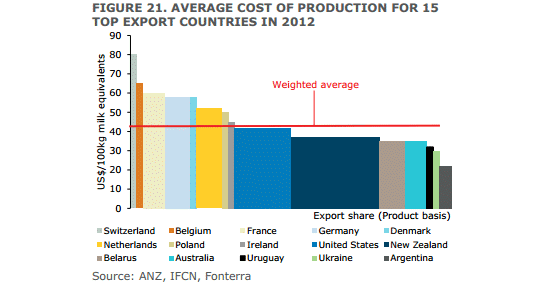
Analysing the cost of milk production for the key exporters suggests a milk price of at least US$35/100kg milk equivalents is required for the lower-cost producers to be incentivised to grow production. In Europe, something around the US$45-55/100kg milk equivalent mark will be required to stimulate investment following quota abolition. Europe’s cost of production seems to generally be at the higher end of the spectrum. The US sits around the top 15 export country average at US$42/100kg milk equivalents, but as our previous analysis has shown there is a wide differential between small and large operations.
Based on the average cost of production at USD$43/100 kg milk equivalent this translates into a milk price of around the US$0.44 per litre mark. Converted to a milk solids basis this is US$5.90, or NZ$7.85 at an NZD/USD of 0.75. Analysing the more efficient European producers down to the bottom quartile suggests long-term milk powder prices need to be between US$3,300 to early US$4,000 per tonne to encourage longer-term investment in supply capacity.
For New Zealand dairy farmers this translates into a medium term range of $6-to-$7/kg MS depending on market conditions and the NZD. This delivers a mid-point of $6.50/kg MS, which happens to be very close to the 7-year average milk price of $6.63/kg MS.
While we expect there is a fair amount of downward pressure emerging on the cost curve at present from lower energy and feed prices, the most recent GDT prices (US$2,800/tonne) are still below break-even for the most efficient producing countries.
Given the weaker demand environment and bow wave of milk leaving inventory to be worked through, we expect only a gradual recovery toward the bottom of the US$3,300 to low-$4,000/tonne band.
CONCLUSION
The most recent GDT auction suggests the tide has turned for dairy prices.
However, we still expect the recovery from here to be more modest due to a weaker demand backdrop, downward pressure on the cost curve and European competition.
We project milk powder prices to recover to around the low US$3,000 per tonne mark by the middle of the year and then US$3,300-US$3,500 per tonne by early 2016. This means a farm-gate milk price of $4.50-$4.70/kg MS beckons in 2014/15.
We’re also currently expecting a softer opening price in May around the $5.75/kg MS mark, although we expect a further uplift toward the low-mid $6/kg MS mark as the season progresses.
While there are lots of moving pieces at present, which could change this view, cash-flow looks tight through the second half of 2015 under a number of scenarios.
This will make the next 18 months very difficult for farmers’ cash-flow and ability to balance the books.
It will necessitate a cut in not just capital and discretionary expenditure, but also some core operating expenditure categories to breakeven and avoid a debt blowout.
-----------------------------------------------------------------------------------
*This report was written by the ANZ New Zealand economics team which consists of chief economist Cameron Bagrie, senior rates strategist David Croy, senior economists Sharon Zollner and Mark Smith, economist Peter Gardiner, senior FX strategist Sam Tuck, and rural economist Con Williams. It is used with permission.
A link to Theme 1 - Change is the new normal, is here.
A link to Theme 2 - Localised focal points, is here.
A link to Theme 3 - The trend is your friend, is here.
A link to Theme 4 - Our key downside risk, is here.
A link to Theme 5 - Liquidity vs fundamentals, is here.
A link to Theme 6 - Addressing income inequality, is here.
2 Comments
Looking at that, I see our main export market has a lower cost of production then we do. Most of the main exporters are getting a higher farmgate milkprice then NZ. Shakey ground indeed, I wonder how they justify 50-60k per ha?
It's my opinion that the same thing has happened to dairy as has happened to oil. Increasing production costs have pushed the price beyond what marginal consumers can afford, causing demand destruction.
The milk price predictors have lost all credibility, after years of being wrong by a massive margin, I wonder why they still bother, and if anyone is still listening to them.
The cost of production analysis is brave (system variation noted aside).
eg. 1. Fx tuff to assume - even historically - see the 1997 to 2015 images at page bottoms,
http://www.anz.co.nz/personal/migrants-travel-foreign-exchange/fx/exchange-rate-graphs/nzd-usd/
http://www.anz.co.nz/personal/migrants-travel-foreign-exchange/fx/exchange-rate-graphs/nzd-eur/
can we compare a 2012 rate with what was wekk before last? and, then there is the hedge.
eg. 2. China low cost, how so then Modern Dairy (big as) given such a hard mark back in Oct14
China has no competitive advantage in pure dairy farming
In this report, we illustrate the competitive disadvantage that Chinese dairy farmers face compared to the rest of the world due to structurally higher corn (primary feed) costs.
We show that on a per unit basis, it would be very difficult for pure dairy farmers to generate cash profit if raw milk prices come under pressure due to global over-supply. This is unless they can achieve productivity improvement (i.e. yield/cow/year) and for which we see limited room for CMD given it has already reached the global best practice benchmark of 9.0 ton yield in 1H14.
As such, we expect the upstream business to see unwinding per unit profitability as pressure on domestic raw milk prices mount due to large supplies of lower priced dairy products internationally. We forecast that while CMD will make Rmb0.45/Kg of raw milk sold for its upstream business in 2014E, this will likely fall to Rmb0.18/Kg in 2015E.

We welcome your comments below. If you are not already registered, please register to comment
Remember we welcome robust, respectful and insightful debate. We don't welcome abusive or defamatory comments and will de-register those repeatedly making such comments. Our current comment policy is here.